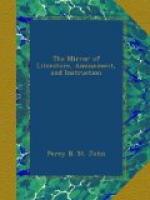Every person is still in the greatest alarm, dreading a second severe shock, which happened last year at the distance of four days from the first grand shock; should this happen now, scarcely one stone will remain upon another in Bogota.
* * * * *
THE DRAUGHTSMAN;[3] OR, HINTS ON LANDSCAPE PAINTING.
[Footnote 3: Vide MIRROR, vol. iv. pp 2, 22, 61, 102.]
OBSERVATIONS ON, AND RULES FOR, SKETCHING.
The following hints, tending to further the tyro’s progress in the delightful art of drawing, will not I trust prove unacceptable to such of your readers as are interested in the subject. For my own use I epitomized various directions relative to sketching, when I met with them in Gilpin’s “Three Essays on Picturesque Beauty,” and I shall feel particularly happy should my attempt at condensing much artistical matter from that interesting volume prove useful to the amateur: the professor undergoes a regular, severe, but essential course of study in that beautiful art, which is to purchase for him fame and emolument; but he who takes up his pencil merely for pastime, will do well to regulate its movements by a few rules, not cumbrous to the memory, and of easy application.—It is my intention briefly to state the object of Gilpin’s first and second essays; from the third I have deduced those rules for sketching which appeared most obviously to result from the tenour of his observations:—
Essay 1st discusses the difference between actual and picturesque beauty; smoothness is usually allowed to enter into our ideas of the former, but roughness, or ruggedness is decidedly essential to the latter: for example—The smooth shaven lawn, the neatly turned walk, the classic marble portico, &c. &c. are beautiful; but the ruined castle, the chasmed mountain, the tempestuous ocean, &c. are picturesque, i.e. with appropriate accompaniments; for, after remarking that the sublime and beautiful are, with many persons, the divisions of the picturesque, our acute observer of nature adds, “sublimity alone cannot




